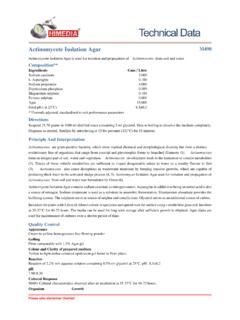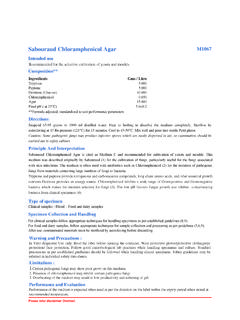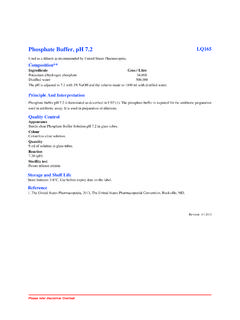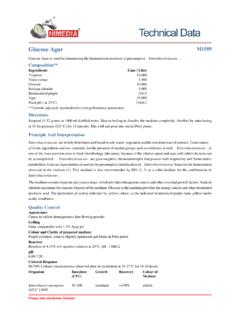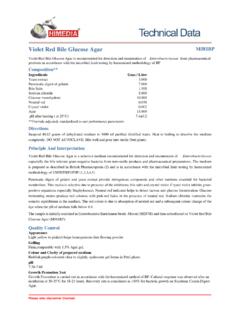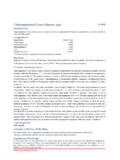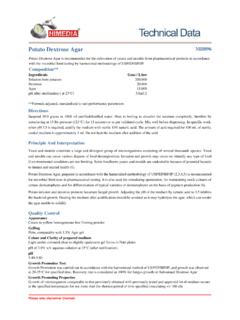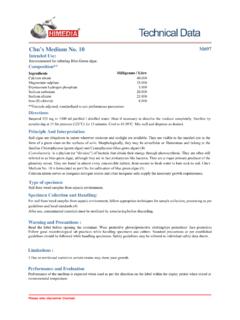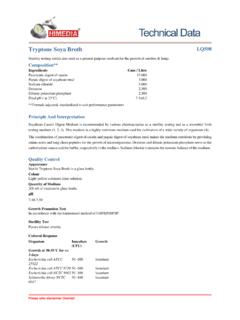Transcription of Xylose-Lysine Deoxycholate Agar (XLD Agar) M031
1 Please refer disclaimer Deoxycholate Agar (XLD Agar) M031 Intended useRecommended for the isolation and enumeration of Salmonella Typhi and other Salmonella species from clinical and non-clinical **IngredientsGms / LitreYeast ammonium pH ( at 25 C) **Formula adjusted, standardized to suit performance parametersDirectionsSuspend grams in 1000 ml purified / distilled water. Heat with frequent agitation until the medium boils. DO NOT AUTOCLAVE OR OVERHEAT. Transfer immediately to a water bath at 50 C. After cooling, pour into sterile Petri plates. It is advisable not to prepare large volumes that will require prolonged heating, thereby producing : Slight precipitation in the medium may occur,which is inheritant property of the medium,and does not affect the performance of the And InterpretationXLD Agar has been recommended for the identification of Enterobacteriaceae (3) and for the microbiological testing.
2 XLD Agar was formulated by Taylor (13-17) for the isolation and differentiation of enteric pathogens including Salmonella Typhi from other Salmonella foods, water and dairy products (2,12,20,21). XLD Agar exhibits increased selectivity and sensitivity as compared to other plating media SS Agar (M108), EMB Agar (M022) and Bismuth Sulphite Agar (M027) (14,16,18, and 4,9,11,19). The media formulation does not allow the overgrowth of other organisms over Salmonella and Shigella (7). Samples suspected of containing enteric pathogens, along with other mixed flora, are initially enriched in Modified Semisolid RV Medium Base (M1482) (1). The medium contains yeast extract, which provides nitrogen and vitamins required for growth. Though the sugars xylose, lactose and sucrose provide sources of fermentable carbohydrates, xylose is mainly incorporated into the medium since it is not fermented by Shigellae but practically by all enterics.
3 This helps in the differentiation of Shigella species. Sodium chloride maintains the osmotic balance of the medium. Lysine is included to differentiate the Salmonella group from the non-pathogens. Salmonellae rapidly ferment xylose and exhaust the supply. Subsequently lysine is decarboxylate by the enzyme lysine decarboxylase to form amines with reversion to an alkaline pH that mimics the Shigella reaction. However, to prevent this reaction by lysine-positive coliforms, lactose and sucrose are added to produce acid in excess. Degradation of xylose, lactose and sucrose to acid causes phenol red indicator to change its colour to yellow. Bacteria that decarboxylate lysine to cadaverine can be recognized by the appearance of a red colouration around the colonies due to an increase in pH. These reactions can proceed simultaneously or successively, and this may cause the pH indicator to exhibit various shades of colour or it may change its colour from yellow to red on prolonged incubation.
4 To add to the differentiating ability of the formulation, an H2S indicator system, consisting of sodium thiosulphate and ferric ammonium citrate, is included for the visualization of hydrogen sulphide produced, resulting in the formation of colonies with black centers. The non-pathogenic H2S producers do not decarboxylase lysine; therefore, the acid reaction produced by them prevents the blackening of the colonies (13).HiMedia LaboratoriesTechnical DataPlease refer disclaimer Agar is both selective and differential medium. It utilizes sodium Deoxycholate as the selective agent and therefore it is inhibitory to gram-positive microorganisms. Quality ControlAppearanceLight yellow to pink homogeneous free flowing powderGellingFirm, comparable with Agar gelColour and Clarity of prepared mediumRed coloured clear to slightly opalescent gel forms in Petri platesReactionReaction of w/v aqueous solution at 25 C.
5 PH : of specimen Clinical samples - Blood, faeces; Food and dairy samples; Water clinical samples follow appropriate techniques for handling specimens as per established guidelines (6,8). For food and dairy samples, follow appropriate techniques for sample collection and processing as per guidelines (12,20). For water samples, follow appropriate techniques for sample collection, processing as per guidelines and local standards.(15) After use, contaminated materials must be sterilized by autoclaving before discarding. Specimen Collection and Handling: Warning and Precautions :In Vitro diagnostic Use . Read the label before opening the container. Wear protective gloves/protective clothing/eye protection/ face protection. Follow good microbiological lab practices while handling specimens and culture. Standard precautions as per established guidelines should be followed while handling clinical specimens.
6 Safety guidelines may be referred in individual safety data and EvaluationPerformance of the medium is expected when used as per the direction on the label within the expiry period when stored at recommended ResponseCultural response was observed after an incubation at 35-37 C for specified time. Recovery rate is considered as 100% forbacteria growth on Soyabean Casein Digest (CFU)GrowthObserved Lotvalue (CFU)RecoveryColour ofColonyIncubationperiodLimitations precipitation in the medium may occur,which is inheritant property of the medium,and does not affect theperformance of the medium is general purpose medium and may not support the growth of fastidious Proteus strains may give red to yellow colouration with most colonies developing black centers, giving rise tofalse positive like Pseudomonas and Providencia may exhibit red Paratyphi A, , S.
7 Pullorum and S. Gallinarum may form red colonies without H2S, thus resemblingShigella TyphimuriumATCC 14028 (00031*)50 -100luxuriant25 -100>=50 %red with blackcentres18 -72 hrsSalmonella Abony NCTC6017 (00029*)50 -100good-luxuriant 25 -100>=50 %red with blackcentres18 -72 hrsHiMedia LaboratoriesTechnical DataEnterobacter cloacae ATCC13047 (00083*)50 -100fair10 -3020 -30 %yellow18 -72 hrsStaphylococcus aureus subsp. aureus ATCC 25923 (00034*)>=104inhibited00%>=72 hrsStaphylococcus aureus subsp. aureus ATCC 6538 (00032*)>=104inhibited00%>=72 hrsEnterococcus faecalis ATCC29212 (00087*)>=104inhibited00%>=72 hrsPlease refer disclaimer Paratyphi A ATCC 915050 -100>=50 %red18 -72 hrsSalmonella Paratyphi B ATCC 875950 -100>=50 %red with blackcentres18 -72 hrsSalmonella Enteritidis ATCC 13076 (00030*)50 -100>=50 %red with blackcentres18 -72 hrsSalmonella Typhi ATCC653950 -100>=50 %red with blackcentres18 -72 hrsShigella dysenteriae ATCC1331350 -100>=50 %red18 -72 hrsShigella flexneri ATCC12022 (00126*)50 -100fair-good15 -4030 -40 %red18 -72 hrsShigella sonnei ATCC 2593150 -100fair-good15 -4030 -40 %red18 -72 hrs# Klebsiella aerogenes ATCC 13048 (00175*)
8 50 -100fair10 -3020 -30 %yellow18 -72 hrsEscherichia coli NCTC 900250 -100fair10 -3020 -30 %yellow18 -72 hrsProteus vulgaris ATCC1331550 -100>=50 %grey with blackcentres18 -72 hrsgood-luxuriant 25 -100 Escherichia coli ATCC 8739 (00012*)50 -100fair10 -3020 -30 %yellow18 -72 hrsEscherichia coli ATCC 25922 (00013*)50 -100fair10 -3020 -30 %yellow18 -72 hrsgood-luxuriant 25 -100 good-luxuriant 25 -100 good-luxuriant 25 -100 good-luxuriant 25 -100 good-luxuriant 25 -100 Key : *Corresponding WDCM numbers.(#) Formerly known as Enterobacter aerogenesStorage and Shelf LifeStore between 10-30 C in a tightly closed container and the prepared medium at 20-30 C. Use before expiry date on the label. On opening, product should be properly stored dry, after tightly capping the bottle in order to prevent lump formation due to the hygroscopic nature of the product.
9 Improper storage of the product may lead to lump formation. Store in dry ventilated area protected from extremes of temperature and sources of ignition Seal the container tightly after use. Use before expiry date on the performance is best if used within stated expiry period. User must ensure safe disposal by autoclaving and/or incineration of used or unusable preparations of this product. Follow established laboratory procedures in disposing of infectious materials and material that comes into contact with clinical sample must be decontaminated and disposed of in accordance with current laboratory techniques (6,8). DisposalPlease refer disclaimer LaboratoriesTechnical W. L. and Schelhart B., 1968, Am. J. Clin. Pathol., 16 W. L. and Schelhart B., 1969, Appl. Microbiol., P., Delisle G. H and Byer M., 1974, Can. J. Microbiol., 20, H.
10 M. and Frank J. H., 2004, Standard Methods for the Microbiological Examination of Dairy Products, 17th Ed.,APHA Inc., Washington, Williams H., (Ed.), 2005, Official Methods of Analysis of the Association of Official Analytical Chemists, 19th Ed., AOAC,Washington, C. and Martin W. J., 1971, Appl. Microbiol., 22, M. A., Beckford O., Belsky R. D and Kostroff B. 1969, Am. J. Clin. Pathol., 51, W. L. and Schelhart B., 1969, Appl. Micro. 18, M. D., 1966, N. Z. J. Med. Lab. Technol., 20, J. F., 1985, Media for Isolation-Cultivation-Identification-Mai ntenance of Medical Bacteria, Vol. 1, Williamsand Wilkins, : 04/ W. L., 1965, Am. J. Clin. Pathol., 44 W. L. and Harris B., 1965, Am. J. Clin. Pathol., 44 W. L. and Harris B., 1967, Am. J. Clin. Pathol., 48 W. L. and Schelhart B., 1967, Am. J. Clin. Pathol., 48 Y., and Tortorello Fifth (Ed.)
